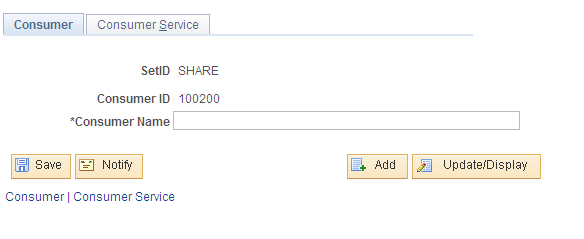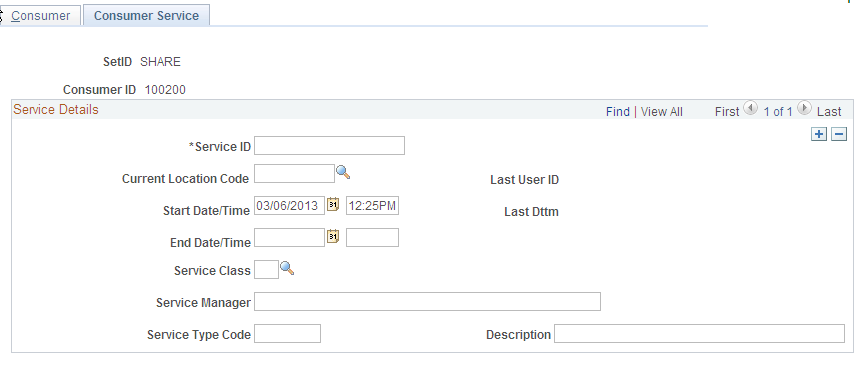Entering Material Usage
To define service class codes, use the Service Class (SRVC_CLASS_INV) component. To define consumers, use the Consumers (CONSUMER_INV) component. To record usage information, use the Record Consumer Usage (USAGE_INV_DE) component.
|
Page Name |
Definition Name |
Usage |
|---|---|---|
|
SRVC_CLASS_INV |
Create service class codes for differentiating the types of services you provide to consumers. You use this information when capturing consumer and service ID data. |
|
|
CONSUMER_INV |
Update basic consumer information received from a third-party consumer management system using the Consumer EIP. |
|
|
CONSMR_SRVC_INV |
Update basic consumer information received from a third-party consumer management system using the Consumer EIP. This page is similar to the Consumer page. |
|
|
USAGE_INV |
Enter and track consumer usage information. |
|
|
USAGE_INV_DE |
Enter usage information manually or with a wedge device. |
To maintain service class codes, use the Service Class (SRVC_CLASS_INV) component.
Use the Service Class page (SRVC_CLASS_INV) to create service class codes for differentiating the types of services you provide to consumers.
You use this information when capturing consumer and service ID data.
Navigation:
This example illustrates the fields and controls on the Service Class page. You can find definitions for the fields and controls later on this page.

To maintain consumer data, use the Consumer Maintenance (CONSUMER_INV) component.
Use the Consumer page (CONSUMER_INV) to update basic consumer information received from a third-party consumer management system using the Consumer EIP.
Use of this page is not intended to replace an admissions system or other system that tracks consumer service activity. Consumer information can also be entered here manually; however, data entered or changed in PeopleSoft Inventory is not updated in the original system.
Navigation:
This example illustrates the fields and controls on the Consumer page. You can find definitions for the fields and controls later on this page.

Use of this page is not intended to replace an admissions system or other system that tracks consumer service activity. Consumer information can also be entered here manually; however, data entered or changed in PeopleSoft Inventory is not updated in the original system.
To receive consumer data from a third-party consumer management system, use the Consumer Message EIP.
The consumer data on this page and stored in PeopleSoft Inventory is the minimum amount of information you need to generate meaningful reconciliation and material usage reports. This information is also sent to third-party consumer billing or costing accounting system.
Note: Ideally, the consumer information should be populated by the Consumer Message EIP. Use Add mode only as support when the third-party consumer management system is down and material usage for a new consumer must be captured.
Field or Control |
Description |
|---|---|
Consumer Name |
Displays the name uploaded from the third-party product. If you are entering this information manually, enter the consumer's name using the standard PeopleSoft naming convention. |
Use the Consumer Service page (CONSMR_SRVC_INV) to update basic consumer information received from a third-party consumer management system using the Consumer EIP.
This page is similar to the Consumer page.
Navigation:
This example illustrates the fields and controls on the Consumer Service page. You can find definitions for the fields and controls later on this page.

Each consumer entered in PeopleSoft Inventory has one or more service IDs. The service event associated with a service ID carries with it the values entered in the fields on this page.
Field or Control |
Description |
|---|---|
Current Location Code |
Select a code that corresponds to the consumer's current location. |
Service Class |
Select a service class that corresponds to the service being performed for the consumer. Service class codes are defined on the Service Class page. |
Service Manager |
Enter the name of the person who managed the consumer's service event, using the standard PeopleSoft naming format. |
Service Type Code |
Enter the appropriate code and description. In a healthcare environment, the service type code could be an ICD-9 code. |
To track consumer usage data, use the Consumer Usage (USAGE_INV) component.
Use the Consumer Usage page (USAGE_INV) to enter and track consumer usage information.
Navigation:
The values for the Usage Tracking, Reconcile, and Charge Code fields on this page are retrieved for the selected item from the par location-line level or the SetID-item level, depending upon whether the item is associated with the selected par location.
Field or Control |
Description |
|---|---|
Service Date |
Enter the date on which the consumer usage occurred. The default date for new rows entered is the current system date. You cannot add a charge for a consumer ID with a service date that is earlier than the service event start date or later than the service event end date. |
Sequence Number |
The numeric sequence in which items were used over the course of one day. The sequence number restarts from 1 when you enter a different item or when you enter the same item with a different date. |
ChartField Overrides |
Click to access the ChartField Overrides page, where you can view, enter, and override header-level ChartField information for default values to each usage line entered. If the selected location is a par location, the par location header-level ChartFields assigned on the Define Par Location Groups page appear as the default values on the ChartField Overrides page. If the location entered is not a par location, these ChartFields can be entered manually at the header level so that they are defaults for each usage line entered. |
Quantity Used |
Enter the quantity of items used in the consumer's service event. The default value is 1. |
UOM (unit of measure) |
Enter the unit of measure in which the item was used. The default value is the standard (dispensing) UOM for the selected item, as defined on the Define Item - General: Common page. |
Reconcile |
Select to reconcile the item. If this is a par location item, this value is set on the Define Par Location - Line Details page. If this is not a par location item, this value is set on the Define Business Unit Item - General: Usage page. If this item is not defined on the Define Business Unit Item page, this value is set on the Define Item - General: Usage page. |
Last PO Price (last purchase order price) |
Displays the last price paid for the item, for informational purposes only. |
The Usage Tracking, Reconcile check box, and Charge Code values on this page are retrieved for the selected item from the par location-line level or the Set ID-item level depending upon whether the item is associated with the selected par location.
To enter consumer usage data, use the Consumer Usage-Data Entry (USAGE_INV_DE) component.
Use the Consumer Usage Entry page (USAGE_INV_DE) to enter usage information manually or with a wedge device.
Navigation:
This data-entry page is compatible with a wedge device, enabling the wanding of the consumer ID and corresponding item labels from consumer charge sheets. The default service ID value is determined by retrieving the most current service event for the consumer ID entered.
The values for the Charge Code, Usage Tracking, and Reconciliation fields are retrieved for the item from the par location-line level, business unit-item level, or SetID-item level depending on whether the item is associated with the selected par location.
Field or Control |
Description |
|---|---|
Location Level ChartFields |
Click to access the ChartField Overrides page, where you can view, enter, and override location-level ChartField information. If the selected location is a par location, the par location item-level ChartFields assigned on the Define Par Location - Line page appear as the defaults on the ChartField Overrides page. If the location entered is not a par location, default item-level ChartFields come from the ChartFields defined on location level. |
Service Date |
The date on which the consumer's usage of the item occurred. By default, this is the current date. You cannot add a charge for a consumer ID with a service date that is earlier than the service event start date or later than the service event end date. |
Material Reconciliation Flag |
When selected, the item will be reconciled. If this is a par location item, this value is set on the Define Par Location - Line Details page. If this is not a par location item, this value is set on the Define Business Unit Item - General: Usage page. If this item is not defined at the business unit level, this value is set on the Define Item - General: Usage page. |
Last PO Price Paid (last purchase order price paid) |
Displays the last price paid for the item, for informational purposes only. |
Item Level ChartFields |
Click to access the ChartField Overrides page, where you can view, enter, and override item-level ChartField information. If the selected location is a par location, the par location item-level ChartFields assigned on the Define Par Location - Line page appear as the defaults on the ChartField Overrides page. If the location entered is not a par location, default item-level ChartFields come from the ChartFields defined on the location level. |